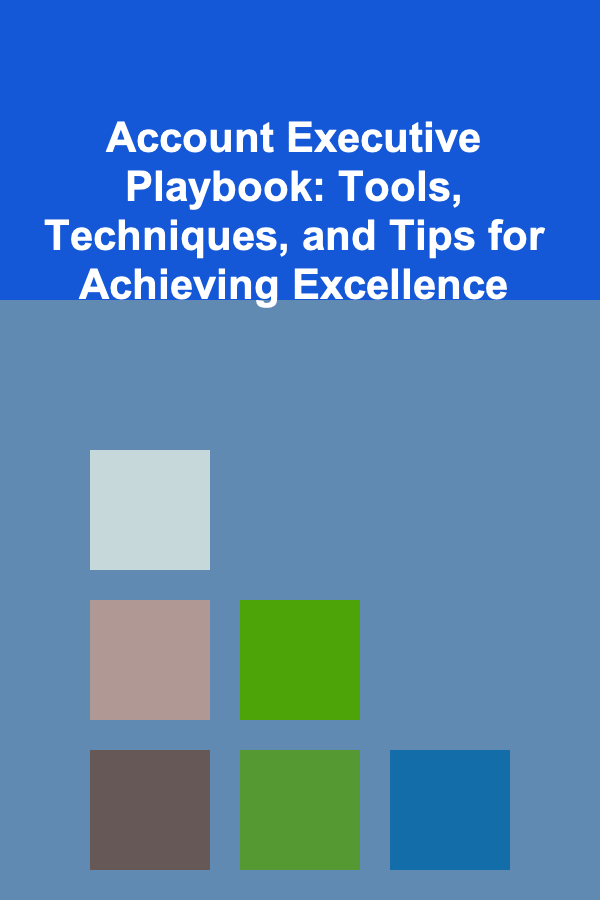
Account Executive Playbook: Tools, Techniques, and Tips for Achieving Excellence
ebook include PDF & Audio bundle (Micro Guide)
$12.99$9.99
Limited Time Offer! Order within the next:

An Account Executive (AE) plays a pivotal role in driving sales, nurturing client relationships, and contributing to a company's overall growth. However, success in this role requires more than just understanding the product---it demands a comprehensive strategy that combines the right tools, techniques, and a mindset of continuous improvement. This playbook is designed to provide actionable insights for AEs to excel in their role, covering key tools, techniques, and tips for achieving excellence.
Tools Every Account Executive Should Master
Success in sales relies heavily on having the right tools at your disposal. The tools used by an AE should streamline tasks, enhance productivity, and help manage relationships effectively. Below are some essential tools that every AE should become proficient with.
1. Customer Relationship Management (CRM) Systems
A CRM system is perhaps the most important tool for any AE. It centralizes all customer interactions, tracks leads, and manages opportunities in one place. CRMs like Salesforce , HubSpot , and Zoho allow AEs to track communications, log calls and meetings, and follow up with clients effectively.
Why it's essential:
- Centralized Data: All client interactions are stored in one place, ensuring you don't miss any important follow-ups.
- Pipeline Management: A good CRM system helps you visualize and manage the stages of your sales pipeline, making it easier to close deals.
- Automated Tasks: CRMs can automate follow-ups, send reminders, and even assist in generating reports to track sales performance.
2. Sales Engagement Tools
To manage outreach at scale, AEs need sales engagement tools like Outreach , SalesLoft , and Apollo.io. These tools help automate email outreach, sequence follow-ups, and integrate seamlessly with CRMs to improve efficiency.
Why it's essential:
- Efficiency: Automates repetitive tasks, allowing AEs to focus on personalizing high-value conversations.
- Data-Driven Insights: Helps analyze the effectiveness of outreach campaigns, enabling AEs to adjust their strategies accordingly.
- Multi-Channel Outreach: Supports email, phone calls, and social media outreach in a unified platform, making it easier to reach prospects through their preferred channels.
3. Proposal and Contract Management Tools
Tools like Proposify , PandaDoc , and DocuSign allow AEs to create customized proposals and streamline the contract signing process. These tools can make the process of submitting quotes, proposals, and contracts much more efficient, reducing delays and improving client experience.
Why it's essential:
- Professionalism: Ensures that your proposals are polished, branded, and legally compliant.
- E-signatures: Speeds up the contract process by allowing clients to sign documents online.
- Tracking: These tools offer real-time tracking of when proposals are opened, viewed, and signed, helping AEs stay on top of deals.
4. Sales Intelligence Tools
Sales intelligence tools like LinkedIn Sales Navigator , Clearbit , and ZoomInfo provide valuable insights into prospecting and lead generation. They give access to deep data on potential clients, including company size, job titles, and even financial information that could be useful in sales conversations.
Why it's essential:
- Enhanced Prospecting: Helps AEs identify the right decision-makers and key players within a company.
- Personalization: Provides detailed insights into a prospect's background and interests, allowing AEs to craft more personalized outreach.
- Competitive Intelligence: Helps AEs understand their competition and craft a better value proposition.
Techniques for Success
In addition to the right tools, an AE needs to hone specific techniques that can increase efficiency, boost performance, and ultimately result in higher conversion rates. Here are several techniques that have been proven to drive success.
1. Consultative Selling Approach
Rather than simply selling a product or service, an AE using a consultative selling approach acts as a trusted advisor, understanding the client's needs, and tailoring the solution to fit those needs.
Key steps in consultative selling:
- Discovery Calls: Begin with open-ended questions to understand the client's challenges, goals, and priorities.
- Active Listening: Pay close attention to the client's pain points, priorities, and concerns. Use these insights to guide your recommendations.
- Solution Tailoring: Position your product or service as the solution to the client's specific challenges, demonstrating how it aligns with their objectives.
2. Effective Time Management
An AE's day is filled with numerous tasks, including prospecting, meetings, follow-ups, and deal management. Effective time management is key to ensuring that all tasks are completed efficiently and that you stay focused on high-priority activities.
Time management tips:
- Block Your Calendar: Set aside dedicated blocks of time for prospecting, meetings, and follow-ups. Treat these blocks as non-negotiable.
- Prioritize Your Tasks: Use tools like the Eisenhower Matrix to prioritize tasks based on urgency and importance.
- Delegate When Necessary: If you're overwhelmed with administrative tasks, delegate them to other team members or use automation tools to reduce your workload.
3. Emotional Intelligence (EQ)
Sales is as much about building relationships as it is about closing deals. Emotional intelligence (EQ)---the ability to understand, manage, and influence emotions---is critical for successful account management. By mastering EQ, an AE can handle client concerns more effectively, maintain rapport, and close deals with empathy and trust.
Key components of EQ in sales:
- Self-Awareness: Recognize your own emotional triggers and how they influence your decision-making and interactions.
- Empathy: Put yourself in the client's shoes to better understand their needs and emotions.
- Adaptability: Be flexible in your approach to different client personalities and changing circumstances.
4. Follow-Up Strategy
One of the most powerful techniques an AE can use is a well-planned follow-up strategy. Successful follow-up shows that you are organized, professional, and committed to meeting the client's needs. However, knowing when and how to follow up is essential to avoid coming across as pushy.
Follow-up best practices:
- Set Clear Expectations: During your initial conversation, set clear timelines for when the next step will occur. For example, "I'll send over the proposal by Friday, and then we can discuss it on a call next Tuesday."
- Use Multiple Channels: Don't rely solely on email. Mix up your follow-ups with phone calls, LinkedIn messages, or even text messages, depending on the client's preferences.
- Personalize: Tailor each follow-up message based on previous conversations. A generic follow-up can come off as lazy or uninterested.
Tips for Achieving Excellence
Being a successful AE goes beyond mastering tools and techniques---it's about cultivating a mindset that drives excellence in every aspect of your role. Here are some additional tips for sustained success:
1. Focus on Long-Term Relationships, Not Just Short-Term Sales
While closing deals is important, the ultimate goal of an AE should be to build long-term relationships. Happy clients lead to repeat business, referrals, and a positive reputation in the market.
How to build long-term relationships:
- Be Client-Centric: Always prioritize the client's needs and long-term success over a quick sale.
- Provide Ongoing Support: Stay involved even after the sale is made, offering support and guidance to ensure the client is satisfied with the product.
- Nurture Relationships: Regularly check in with clients even when they don't have immediate needs. This can foster goodwill and open the door for future business opportunities.
2. Invest in Continuous Learning
Sales is an ever-evolving field, and the best AEs are always looking to improve their skills. Whether it's learning about new sales methodologies, improving communication techniques, or mastering new tools, continuous learning is key to staying competitive.
How to invest in continuous learning:
- Attend Workshops and Webinars: Stay updated on the latest trends in sales by attending events and training sessions.
- Seek Feedback: Regularly ask for feedback from colleagues, mentors, and clients. Constructive feedback can provide valuable insights into areas where you can improve.
- Read Sales Books and Articles: Keep up with the latest strategies and best practices in sales by reading books, blogs, and industry reports.
3. Stay Resilient
Sales can be challenging, and not every conversation will result in a closed deal. Resilience is crucial to maintaining a positive attitude and staying motivated, even when things don't go as planned.
Resilience tips:
- Learn from Rejection: Use every "no" as an opportunity to learn and improve. Analyze what went wrong and how you can adjust your approach next time.
- Maintain a Positive Mindset: Cultivate a growth mindset that focuses on continual improvement and viewing challenges as learning opportunities.
Conclusion
Becoming an exceptional Account Executive requires the right tools, techniques, and mindset. By mastering essential tools like CRMs and sales engagement platforms, refining your sales techniques, and continuously striving for improvement, you can elevate your performance and make a lasting impact. Remember, excellence in sales doesn't happen overnight---it's a journey of consistent effort, adaptability, and commitment to client success. Embrace the playbook, put it into practice, and watch as you thrive in the dynamic world of sales.

How to Create a Checklist for Organizing Your First Book Club Meeting
Read More
How to Maintain Your Home's Smart Home Devices
Read More
How to Research Market Trends for Effective Staging
Read More
How to Slash Your Internet and Cable Bills Without Losing Service
Read More
Mastering the Legal Assistant Role: Advanced Strategies for Supporting Legal Professionals
Read More
How to Taste Wine from Different Regions
Read MoreOther Products

How to Create a Checklist for Organizing Your First Book Club Meeting
Read More
How to Maintain Your Home's Smart Home Devices
Read More
How to Research Market Trends for Effective Staging
Read More
How to Slash Your Internet and Cable Bills Without Losing Service
Read More
Mastering the Legal Assistant Role: Advanced Strategies for Supporting Legal Professionals
Read More